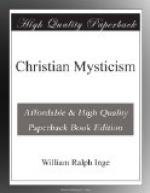The second is the belief in the immanence of a God who is also transcendent. This should be called Panentheism, a useful word coined by Krause, and not Pantheism. In its true form it is an integral part of Christian philosophy, and, indeed, of all rational theology. But in proportion as the indwelling of God, or of Christ, or the Holy Spirit in the heart of man, is regarded as an opus operatum, or as complete substitution of the Divine for the human, we are in danger of a self-deification which resembles the maddest phase of Pantheism[187].
Pantheism, as I understand the word, is a pitfall for Mysticism to avoid, not an error involved in its first principles. But we need not quarrel with those who have said that speculative Mysticism is the Christian form of Pantheism. For there is much truth in Amiel’s dictum, that “Christianity, if it is to triumph over Pantheism, must absorb it.” Those are no true friends to the cause of religion who would base it entirely upon dogmatic supernaturalism. The passion for facts which are objective, isolated, and past, often prevents us from seeing facts which are eternal and spiritual. We cry, “Lo here,” and “Lo there,” and forget that the kingdom of God is within us and amongst us. The great service rendered by the speculative mystics to the Christian Church lies in their recognition of those truths which Pantheism grasps only to destroy.
FOOTNOTES:
[Footnote 107: The mention of Heraclitus is very interesting. It shows that the Christians had already recognised their affinity with the great speculative mystic of Ephesus, whose fragments supply many mottoes for essays on Mysticism. The identification of the Heraclitean [Greek: nous-logos] with the Johannine Logos appears also in Euseb. Praep. Ev. xi. 19, quoted above.]
[Footnote 108: [Greek: ho panta aristos Platon—oion pheothoroumenos], he calls him.]
[Footnote 109: “Mysticism finds in Plato all its texts,” says Emerson truly.]
[Footnote 110: The doctrine of reserve in religious teaching, which some have thought dishonest, rests on the self-evident proposition that it takes two to tell the truth—one to speak, and one to hear.]
[Footnote 111: “Man kann den Gnosticismus des zweiten Jahrhunderts als theologisch-transcendente Mystik, und die eigentliche Mystik als substantiell-immanente Gnosis bezeichnen” (Noack).]
[Footnote 112: See Conybeare’s interesting account of the Therapeutae in his edition of Philo, On the Contemplative Life, and his refutation of the theory of Lucius, Zeller, etc., that the Therapeutae belong to the end of the third century.]
[Footnote 113: Stoical influence is also strong in Philo.]
[Footnote 114: The Jewish writer Aristobulus (about 160 B.C.) is said to have used the same argument in an exposition of the Pentateuch addressed to Ptolemy Philometor.]




